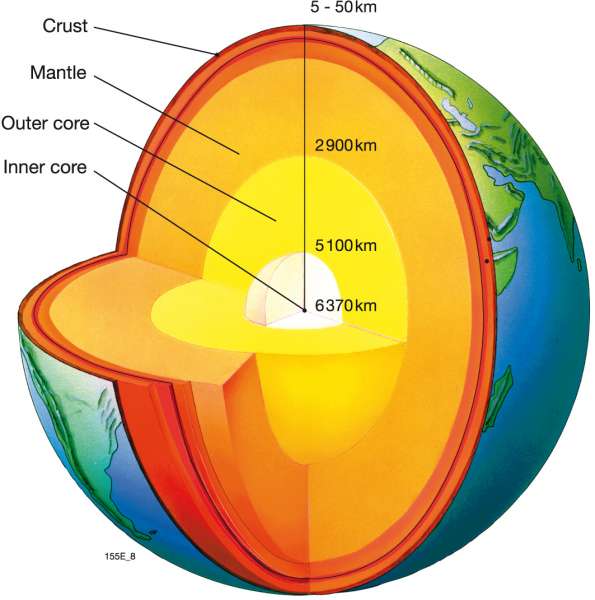

What Is The Earth's Crust Thickness?
The Earth's crust thickness is a fundamental aspect of our planet's geology that plays a crucial role in understanding plate tectonics, geological formations, and the overall structure of the Earth. In this article, we will delve into the various layers of the Earth, focusing on the thickness of the crust and its significance in geological studies. The Earth's crust is the outermost layer of our planet, and its characteristics can vary significantly from one location to another. Understanding the thickness of the Earth's crust is essential for geologists, seismologists, and anyone interested in the science of our planet.
Throughout this article, we will explore the different types of crust, how thickness varies across the globe, and the implications of these variations. We will also discuss how advancements in technology have allowed scientists to measure the Earth's crust more accurately. By the end of this article, you will have a comprehensive understanding of the Earth's crust thickness and its importance in the field of geology.
The Earth's crust thickness is not merely a subject of academic interest; it has real-world implications for natural disasters, resource exploration, and understanding Earth's history. Whether you are a student, a professional in the field, or simply curious about our planet, this article will provide valuable insights into the Earth's crust.
Table of Contents
- Understanding the Earth's Layers
- Types of Earth's Crust
- How Thick is the Earth's Crust?
- Variations in Crust Thickness
- Measuring the Earth's Crust
- Implications of Crust Thickness
- Conclusion
- References
Understanding the Earth's Layers
The Earth is composed of several layers, each with distinct properties and characteristics. The major layers include:
- Crust: The outermost layer, where we live.
- Mantle: Located beneath the crust, made of semi-solid rock.
- Outer Core: A liquid layer composed mainly of iron and nickel.
- Inner Core: A solid center composed of iron and nickel.
The Earth's crust varies in thickness and composition, which influences geological processes and phenomena. Understanding these layers is essential for comprehending the Earth’s crust thickness.
Types of Earth's Crust
There are two main types of Earth's crust: continental crust and oceanic crust.
Continental Crust
The continental crust is thicker than oceanic crust, averaging about 30-50 kilometers (18-31 miles) in thickness. It is primarily composed of granitic rocks and is less dense than oceanic crust.
Oceanic Crust
Oceanic crust is thinner, averaging about 5-10 kilometers (3-6 miles) in thickness. It is primarily composed of basaltic rocks and is denser than continental crust. The differences in density and thickness between these two types of crust contribute to the dynamics of plate tectonics.
How Thick is the Earth's Crust?
The thickness of the Earth's crust varies significantly across different regions:
- Average Thickness: The average thickness of the Earth's crust is approximately 30 kilometers (18.6 miles).
- Continental Regions: In mountain ranges, the crust can be up to 70 kilometers (43 miles) thick.
- Oceanic Regions: In oceanic areas, the crust is generally around 5-10 kilometers (3-6 miles) thick.
These variations play a critical role in geological activities such as earthquakes and volcanic eruptions, which are often influenced by the thickness and composition of the Earth's crust.
Variations in Crust Thickness
The Earth's crust thickness is not uniform. Several factors contribute to these variations:
- Geological Activity: Areas with significant tectonic activity, such as the Himalayas, tend to have thicker crusts.
- Type of Crust: Continental crust is generally thicker than oceanic crust.
- Age of the Crust: Older crust tends to be thicker as it has had more time to accumulate geological material.
Research shows that the thickness can vary greatly even within short distances, highlighting the complex nature of Earth's geology.
Measuring the Earth's Crust
Scientists use various methods to measure the Earth's crust thickness, including:
- Seismic Surveys: By analyzing seismic waves generated by earthquakes, scientists can infer the thickness of the crust.
- Gravity Measurements: Variations in gravity can indicate differences in crust thickness.
- Drilling Projects: Direct drilling into the crust provides precise data about its composition and thickness.
Advancements in technology have greatly improved the accuracy and efficiency of these measurements, allowing for a better understanding of the Earth's structure.
Implications of Crust Thickness
The thickness of the Earth's crust has significant implications for various fields:
- Earthquakes: Thicker crust can lead to more intense seismic activity.
- Resource Exploration: Understanding crust thickness is essential for locating natural resources like minerals and fossil fuels.
- Geological Research: Variations in crust thickness provide insights into Earth's geological history and processes.
Overall, the Earth's crust thickness is a critical factor in understanding the planet's geology and its dynamic nature.
Conclusion
In conclusion, the Earth's crust thickness varies significantly between continental and oceanic regions, with an average thickness of about 30 kilometers (18.6 miles). Understanding the crust's structure and thickness is essential for comprehending geological processes, predicting natural disasters, and exploring natural resources. We encourage readers to share their thoughts on this topic in the comments section below and explore more articles related to Earth sciences.
References
For further reading and to support the information provided in this article, please refer to the following reputable sources:
- US Geological Survey (USGS) - https://www.usgs.gov/
- National Geographic - https://www.nationalgeographic.com/
- Geological Society of America - https://www.geosociety.org/
Village Health Urgent Care: Your Go-To Solution For Immediate Medical Needs
Understanding "No Caller ID": What Does It Mean?
Unforgettable Experiences At Card Party Orlando: A Guide To The Ultimate Gaming Event


